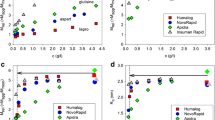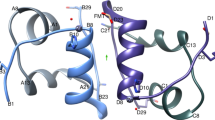Abstract
In a study aimed at the development of a long-acting insulin preparation, Manallack and co-workers (5) reported on the design of small organic molecules which have the potential to bind to insulin and stabilize its hexameric aggregate. Two of the molecules that were designed with their computer graphics program were thought to be particularly promising as ligands: benzene-p-disulfonate and benzene-p-diphosphonate. In the present work, the insulin binding abilities of these molecules have been thoroughly tested. A theoretical binding program, GRID, was used to calculate the binding energetics of the molecules and to predict the most probable site of their binding. Microcalorimetry and NMR line broadening techniques were used to measure the actual binding reactions of the ligands. For both compounds, no evidence of binding to insulin was ever observed in either the microcalorimetry or the NMR studies. In contrast, a series of phenolic ligands commonly used as preservatives for insulin showed evidence of substantial binding using either method. An explanation has been proposed for this apparent discrepancy between computer predictions and actual experimental data: The theoretical programs do not take solvation effects of the aqueous medium into account. Solvation effects would tend to inhibit binding of the ionized ligand molecules due to charge delocalization and steric crowding.
Similar content being viewed by others
REFERENCES
J. C. Kendrew, R. E. Dickerson, B. E. Strandberg, R. G. Hart, D. R. Davies, D. C. Phillips, and V. C. Shore. Nature 181:662–666 (1958).
C. R. Beddell, R. J. Goodford, F. E. Norrington, S. Wilkinson, and R. Wootton. Br. J. Pharmacol. 82:397–407 (1984).
P. J. Goodford. J. Med. Chem. 27:557–564 (1984).
P. J. Goodford. J. Mol. Graph. 3:107–108 (1985).
D. T. Manallack, P. R. Andrews, and E. F. Woods. J. Med. Chem. 28:1522–1526 (1985).
P. J. Goodford. J. Med. Chem. 28:849–857 (1985).
D. T. Manallack. Design of Long-Acting Insulin Preparations, Master of pharmacy thesis, Victorian College of Pharmacy, Parkville, Vic. 3052, Australia, 1984.
F. C. Bernstein, T. F. Koetzle, G. J. B. Williams, E. F. Meyer, M. D. Brice, J. R. Rodgers, O. Kennard, T. Shimanouchi, and M. Tasumi. J. Mol. Biol. 112:535–542 (1977).
T. L. Blundell, G. Dodson, D. Hodgkin, and D. Mercola. Adv. Protein Chem. 26:279–402 (1972).
H. Meerwein, G. Dittmar, R. Gollner, K. Hafnar, F. Mensch, and O. Steinfort. Chem. Ber. 99:841–852 (1957).
P. G. Chantrell, C. A. Pearce, C. R. Toyer, and R. Twaits. J. Appl. Chem. 14:563–564 (1964).
S. E. McGraw and S. Lindenbaum. Pharm. Res. 7:606–611 (1990).
S. O. Emdin, G. G. Dodson, J. M. Cutfield, and S. M. Cutfield. Diabetologia 19:174–182 (1980).
T. J. Swift and R. E. Connick. J. Chem. Phys. 37:307–320 (1962).
M. Blumenstein. In The Peptides, Vol. 7, Academic Press, Orlando, FL, 1985, pp. 355–403.
R. A. Dwek. Nuclear Magnetic Resonance in Biochemistry: Application to Enzyme Systems, Oxford University Press (Clarendon), London and New York, 1973.
O. Jardetzky and G. C. K. Roberts. NMR in Molecular Biology, Academic Press, New York, 1981.
M. J. Pikal. Results of Evaluation of LKB 2277 Calorimeter for Stability Testing of Pharmaceuticals, LKB Application Note 335, LKB Produkter AB, Bromma, Sweden, 1983.
J. L. Sudmeier, S. J. Bell, M. C. Storm, and M. F. Dunn. Science 212:560–562 (1981).
Author information
Authors and Affiliations
Rights and permissions
About this article
Cite this article
McGraw, S.E., Craik, D.J. & Lindenbaum, S. Testing of Insulin Hexamer-Stabilizing Ligands Using Theoretical Binding, Microcalorimetry, and Nuclear Magnetic Resonance (NMR) Line Broadening Techniques. Pharm Res 7, 600–605 (1990). https://doi.org/10.1023/A:1015814110609
Issue Date:
DOI: https://doi.org/10.1023/A:1015814110609




